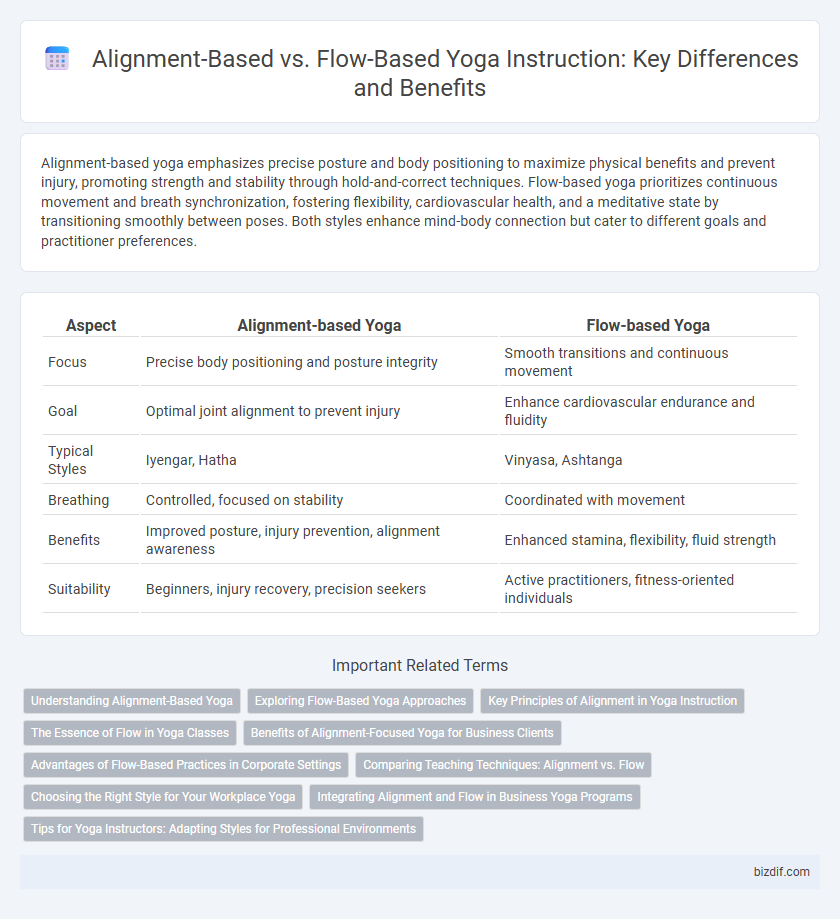Alignment-based yoga emphasizes precise posture and body positioning to maximize physical benefits and prevent injury, promoting strength and stability through hold-and-correct techniques. Flow-based yoga prioritizes continuous movement and breath synchronization, fostering flexibility, cardiovascular health, and a meditative state by transitioning smoothly between poses. Both styles enhance mind-body connection but cater to different goals and practitioner preferences.
Table of Comparison
| Aspect | Alignment-based Yoga | Flow-based Yoga |
|---|---|---|
| Focus | Precise body positioning and posture integrity | Smooth transitions and continuous movement |
| Goal | Optimal joint alignment to prevent injury | Enhance cardiovascular endurance and fluidity |
| Typical Styles | Iyengar, Hatha | Vinyasa, Ashtanga |
| Breathing | Controlled, focused on stability | Coordinated with movement |
| Benefits | Improved posture, injury prevention, alignment awareness | Enhanced stamina, flexibility, fluid strength |
| Suitability | Beginners, injury recovery, precision seekers | Active practitioners, fitness-oriented individuals |
Understanding Alignment-Based Yoga
Alignment-based yoga centers on precise body positioning to maximize safety and effectiveness by emphasizing anatomical correctness in each posture. Techniques prioritize muscle engagement, joint placement, and spinal alignment to prevent injury and enhance strength and flexibility outcomes. Understanding alignment-based yoga requires awareness of subtle adjustments that optimize biomechanical efficiency and promote mindful movement.
Exploring Flow-Based Yoga Approaches
Flow-based yoga approaches emphasize continuous, dynamic movements synchronized with breath, promoting fluid transitions between poses to enhance flexibility and cardiovascular health. This style contrasts with alignment-based yoga, which prioritizes precise posture alignment and static holds for muscle strengthening and injury prevention. Exploring flow-based practices like Vinyasa or Ashtanga can improve body awareness, stamina, and mental focus through rhythmic sequences tailored to individual energy levels.
Key Principles of Alignment in Yoga Instruction
Key principles of alignment in yoga instruction emphasize precise body positioning to ensure safety, prevent injury, and maximize the effectiveness of each pose. Proper alignment engages muscles symmetrically, supports joint health, and enhances breath control, which is crucial for maintaining stability and balance. Teachers observe anatomical landmarks and instruct students to maintain structural integrity, promoting mindful awareness throughout the practice.
The Essence of Flow in Yoga Classes
Flow-based yoga emphasizes seamless movement synchronized with breath, fostering a meditative state that enhances body awareness and mental clarity. Alignment-based yoga prioritizes precise posture adjustments to prevent injury and build foundational strength, promoting stability and structural integrity. Integrating the essence of flow in yoga classes allows practitioners to experience dynamic fluidity while maintaining mindful alignment, optimizing both physical and mental benefits.
Benefits of Alignment-Focused Yoga for Business Clients
Alignment-focused yoga enhances body awareness and reduces injury risk, which supports sustained productivity and workplace wellbeing. Precise postural alignment improves musculoskeletal health, reducing chronic pain commonly associated with sedentary office work. Integrating alignment-based yoga into corporate wellness programs fosters mental clarity, stress relief, and overall employee resilience, driving long-term organizational performance.
Advantages of Flow-Based Practices in Corporate Settings
Flow-based yoga practices enhance employee well-being by promoting continuous movement and mindfulness, which reduces stress and boosts mental clarity. This dynamic approach adapts easily to varied fitness levels, making it accessible and engaging for diverse corporate teams. The combination of sustained energy flow and breath synchronization improves focus and productivity throughout the workday.
Comparing Teaching Techniques: Alignment vs. Flow
Alignment-based yoga teaching emphasizes precise body positioning and muscular engagement to prevent injury and maximize effectiveness. Flow-based methods prioritize continuous movement and breath synchronization, enhancing cardiovascular endurance and mental mindfulness. Comparing both, alignment offers structural stability, while flow cultivates fluidity and energy circulation, allowing practitioners to choose based on personal goals and physical needs.
Choosing the Right Style for Your Workplace Yoga
Alignment-based yoga emphasizes precise postures and body mechanics, ideal for promoting injury prevention and enhancing physical awareness in office settings. Flow-based yoga focuses on smooth, continuous movements synchronized with breath, encouraging stress relief and improving overall workplace energy. Selecting the right style depends on employee needs, whether prioritizing physical alignment or fostering mental relaxation through dynamic sequences.
Integrating Alignment and Flow in Business Yoga Programs
Integrating alignment-based and flow-based approaches in business yoga programs enhances both precision and fluidity, promoting ergonomic health and mental resilience among employees. Alignment-based practices emphasize correct posture and joint safety, reducing injury risks in sedentary office environments. Flow-based sequences cultivate mindfulness and stress relief through continuous movement, supporting overall workplace wellness and productivity.
Tips for Yoga Instructors: Adapting Styles for Professional Environments
Yoga instructors can enhance their teaching by balancing alignment-based precision with flow-based fluidity, ensuring classes meet diverse student needs and professional settings. Emphasizing clear cueing and anatomical awareness supports alignment-focused practices, while integrating breath-synchronized movements nurtures flow-based sessions. Adapting to the environment involves assessing participant goals and space constraints to deliver safe, engaging, and accessible yoga experiences.
Alignment-based vs Flow-based Infographic

 bizdif.com
bizdif.com